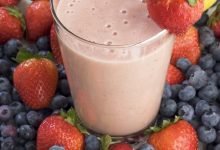🥑🌱 Asparagus Guacamole: A Unique Twist on a Classic!
Asparagus guacamole is a delightful variation of the traditional avocado-based dip, guacamole, where fresh asparagus is the star ingredient. This unique twist adds a touch of earthiness and a vibrant green hue to the classic recipe, making it a delightful treat for your taste buds. Let’s explore the history, components, steps to prepare, and the time needed to whip up this fantastic dish. 🌟
History:
The history of asparagus guacamole is not as well-documented as its avocado counterpart. It is likely a modern culinary invention that emerged as creative chefs sought to experiment with traditional recipes. The idea behind this variation might be to incorporate more green vegetables and add a unique flavor and texture to the beloved dip.
Components:
To make a delicious asparagus guacamole, you’ll need the following components:
- Asparagus: The star of the show! You’ll need fresh asparagus spears, which you’ll blanch and then blend into a smooth puree.
- Avocado: This is where the guacamole gets its creamy texture. Ripe avocados are essential.
- Lime Juice: For that zesty tang.
- Cilantro: Fresh cilantro leaves add a burst of freshness.
- Garlic: Minced or crushed garlic cloves for that savory kick.
- Jalapeño: If you like a bit of heat, you can add minced jalapeño pepper.
- Salt and Pepper: To taste.
Steps to Prepare Asparagus Guacamole:
-
Blanch the Asparagus: Start by trimming the tough ends of the asparagus. Boil water and prepare a bowl of ice water. Blanch the asparagus in the boiling water for about 2-3 minutes until tender but still vibrant green. Then, immediately transfer them to the ice water to stop the cooking process. Drain and set aside.
-
Blend Asparagus: In a food processor or blender, combine the blanched asparagus, ripe avocados, lime juice, cilantro, minced garlic, and jalapeño if desired. Blend until the mixture is smooth and creamy.
-
Season: Taste the guacamole and add salt and pepper to your liking. You can also adjust the lime juice or jalapeño for your preferred level of tanginess and spiciness.
-
Serve: Transfer the asparagus guacamole to a serving bowl. You can garnish it with extra cilantro, a drizzle of olive oil, or some finely chopped asparagus tips for presentation.
Time Needed:
The preparation of asparagus guacamole should take approximately 20-30 minutes, including the blanching and blending process. The time may vary depending on your cooking skills and the quantity you’re making.
In conclusion, asparagus guacamole is a creative twist on a classic recipe, and it’s perfect for those who want to try something new and enjoy the fresh, earthy taste of asparagus. Whether you’re dipping tortilla chips, using it as a spread, or incorporating it into various dishes, this guacamole is sure to be a hit at your table. Enjoy your culinary adventure! 🥑🌱🍽️
Certainly! Here are the nutrition facts and some health information related to asparagus guacamole:
Nutrition Facts (Approximate Values per Serving – 2 tablespoons):
- Calories: 50-60 calories
- Total Fat: 4-5 grams
- Saturated Fat: 0.5-1 gram
- Monounsaturated Fat: 2-3 grams
- Polyunsaturated Fat: 0.5-1 gram
- Sodium: 100-150 milligrams
- Total Carbohydrates: 4-6 grams
- Dietary Fiber: 2-3 grams
- Sugars: 1-2 grams
- Protein: 1-2 grams
- Vitamin C: 10-15% of the Daily Value (DV)
- Vitamin K: 15-20% of the DV
- Folate: 10-15% of the DV
- Potassium: 4-6% of the DV
Health Information:
-
Low in Calories: Asparagus guacamole is relatively low in calories, making it a healthy option for those watching their calorie intake.
-
Healthy Fats: Avocado, a key ingredient in guacamole, provides heart-healthy monounsaturated fats, which can help reduce bad cholesterol levels.
-
Dietary Fiber: The dip contains dietary fiber from both avocados and asparagus, which aids in digestion and helps keep you feeling full.
-
Vitamins and Minerals: Asparagus is a good source of vitamins C and K, which support the immune system and bone health. Avocado contributes folate, which is essential for cell division.
-
Potassium: Avocado is rich in potassium, an important mineral for maintaining healthy blood pressure.
-
Phytonutrients: Both asparagus and avocados contain various phytonutrients and antioxidants that may have protective effects against certain diseases.
-
Low Sodium: While the sodium content can vary based on how much salt you add, guacamole itself tends to be relatively low in sodium, which is beneficial for those watching their salt intake.
It’s worth noting that the nutritional content can vary based on the specific ingredients and proportions used in your asparagus guacamole recipe. This information provides a general idea of what you can expect in terms of nutrition and health benefits from this dish. Enjoy your asparagus guacamole as part of a balanced diet for a tasty and nutritious treat! 🥑🌱🍽️




